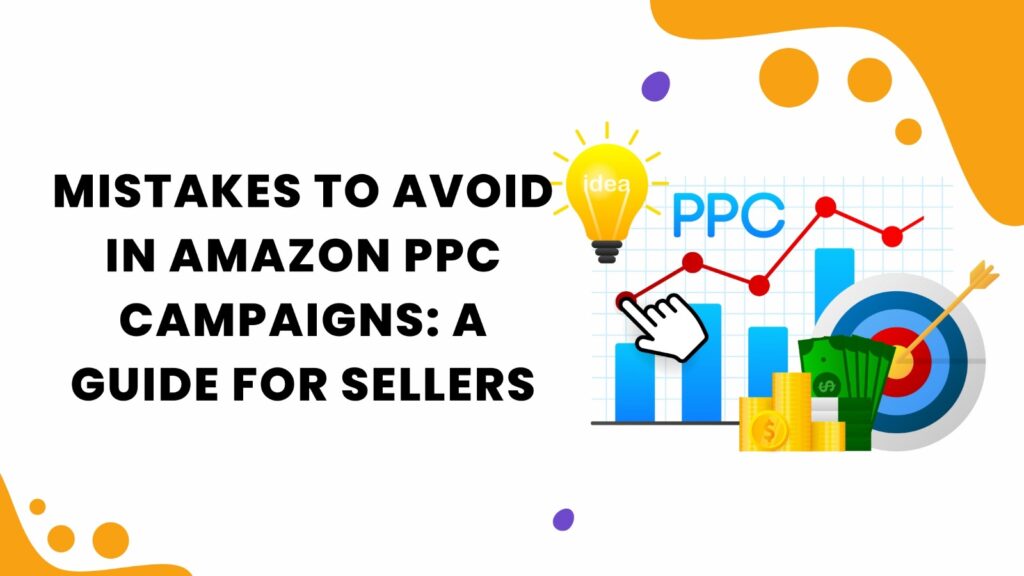
Mistakes to Avoid in Amazon PPC Campaigns: A Guide for Sellers
Amazon PPC is indeed one of the most effective Amazon advertising tools to drive more traffic and eventually result in sales, but it is also complex enough to cause some issues in its process. In many cases, sellers rush to the PPC without fully understanding the nuances and end up making costly mistakes that adversely affect their campaigns.
In this series on avoiding common mistakes in Amazon PPC, getting to the very competitive Amazon marketplace may become your only choice. Therefore, here are the mistakes sellers should avoid when running an Amazon PPC campaign.
8 Mistakes to Avoid in Amazon PPC Campaigns
Negative Keywords Optimization
One blunder sellers make is not using negative keywords. Negative keywords are phrases whose appearance you do not want your ads to be seen in. In case you leave this, then your ads may appear in searches where they’re irrelevant, thereby inefficiently wasting your budget for advertising.
For instance, running ads for luxury leather handbags without including “cheap” or “discount” in your negative keyword list means that such ads will still appear to customers who may be looking for cheaper handbags. Most of these clicks are not converted into sales. So you will be paying extra, which isn’t needed. You have to update your negative keyword list periodically to help target only the right traffic.
Not Having a Clear Budget Strategy
One more significant blunder with Amazon PPC campaigns is the absence of a budget strategy. Every seller sets up a daily budget without knowing how much they should spend for different campaigns and how the latter would influence their general profitability.
In this case, overspending on less-performing keywords can easily lead to a monetary bleed in your profit margins. Otherwise, setting your budget too low may eventually limit the exposure of your ads to fewer opportunities for sales generation. Good practice involves CPC analysis at regular intervals as well as adjustments in terms of your ACoS targets. Monitor your campaigns regularly to avoid budget mismanagement.
Lack of Ad Optimization
Amazon PPC campaigns are always operating under constant optimization. Most sellers tend to commit the wrong move by setting up their campaigns and simply letting them run without further adjustments. The marketplace offered by Amazon is very dynamic, with constant changes happening in competition, keywords, and consumer behavior. What worked last month won’t work today.
Monitoring keyword performance, ad copy updates, variations in match types, which could include broad, phrase, or exact, and touching on the aspect of adjusting the bid for PPC campaigns are all means of optimizing your PPC campaigns. That means this is an optimization and not a money-wasting idea it improves your ROI.
Lack of proper campaign segmentation
Another very common mistake is the failure to segment campaigns properly. Salespeople tend to bundle too many products into a single campaign, making it not easy to differentiate between the real high performers or keywords. Hence, they miss precious insight, which can be useful for the fine-tuning of strategy.
A better alternative approach is to separate products or product categories from each other. You can then set customized budgets, bids, and keywords for each product. Individual performance can also be tracked more effectively, and information can be made on whether certain products should be given a further push or if modifications are needed to the keyword or budget.
Failure in Creating Automated Campaigns
Some of the vendors don’t use automatic campaigns but directly go for manual campaigns, assuming that it’s far more precise and effective. It is true that manual campaigns have much more control within themselves, but then automatic campaigns have their advantages and mustn’t be overlooked.
With automatic campaigns, Amazon’s algorithm will scour through search terms for your products that may have never occurred to you. These are a rich source of data in finding those highly converting keywords that will later be used in manual campaigns. By running both automatic and manual campaigns, you get to capitalize on a much wider scope of search terms.
Using Only One Match Type
In fact, relying on a single match type is actually going to hold the potential of your PPC campaigns. Each match type serves to fulfill a different objective, and failing to use a mix of them can lead to missed opportunities.
Broad match helps you catch a wide range of search terms, which increases the chances of increasing visibility but is not always relevant. The reason phrase match has been doing so well is because it has a balance between reach and relevance; searches involving your exact keyword phrase. An exact match ensures that your ad only shows up when the exact keyword is used, resulting in a high-precision campaign with low reach.
Monitor a mix of ad types to capture different depths of search intent, test them, and make adjustments according to the outcome.
Not Monitoring ACoS Frequently
Advertising Cost of Sales-ACoS is the most important KPI when measuring the effectiveness of your Amazon PPC campaigns. But, surprisingly, so many sellers are not sure how to track their ACoS on an ongoing basis or what they need to see for ACoS, for each of their products.
High ACoS can indicate that you are overpaying for ads but do not seem to generate the same amount of revenue. Low ACoS may indicate that you are underbidding. Keep track of your ACoS to strike the perfect balance of ad spend and profitability. Target ACoS should be set according to business goals, and the budget should be adjusted based on bids and keywords.
Not Using Data Enough
Amazon PPC provides plenty of data such as keyword performance, click-through rates, and conversion rates, among others. Unfortunately, most sellers simply don’t utilize such data to enhance their campaigns. They might look at the metrics but do nothing else but go on with their game plan.
Campaign data analysis will help you figure out where the pieces are working, and where they’re not. Maybe, when a few particular keywords have very high CTRs but somehow fail to produce conversion rates, it’s about time to tweak the ad copy or the landing page. But then again, when a product is that interesting and has a lot of conversions occurring, you can just pull up your bids and take up more of the traffic.
Conclusion
Amazon PPC campaigns can be a huge sales booster for you if you avoid making mistakes. It requires expertise along with continuous management, and GrowithAmazon is here to avoid common pitfalls with the right aid of Advertising Management services on your campaigns, keyword strategy adjustments, and use of data to ensure you are getting the best return from your investment.
With our service, you can grow your business while we take care of the complexity of Amazon PPC. We ensure that all of your campaigns run efficiently and bring back the results you need.


